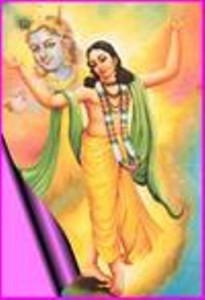*Sri Sri Gour Vidhur Jayati *
With love from the editor
Sri Krishna Chaitanya Mahâprabhu heard a recitation of Sri Krishna-Karnâmritam when He visited South India. He was extremely attracted by its contents and was filled with wonder. He brought a script of this text to Neelâchal. In Sri Chaitanya-Charitâmrita, it is recorded as follows –
“tabe mahaprabhu aila krishnabenva tire,
nana tirtha dekhi tanha debamandire
brahman samaj sab baishnab charita,
baishnab sakal padhe krishna-karnamrita.
karnamrita shuni prabhur ananda hoilo,
agraha koriya punthi lekhaiya nilo.
karnamrita sama bastu nahi tribhubane,
jaha hoite hoy shuddha krishna prema gyâne.
soundarjya – madhurjya krishna – lilar abadhi,
se jane je padhe nirabadhi.”
Meaning – “At last Sriman-Mahâprabhu1 came to the banks of River Krishnavenva. There He visited the holy places and the temples. The people residing there were Vaishnavs from the Brahmin community. All of them read Sri Krishna-Karnâmritam regularly. When the Lord heard Karnâmritam, He was overjoyed and got it copied. He said that there was nothing compared to Karnâmritam in the whole universe and whosoever reads this text gets pure Krishna-prem. He who reads Karnâmritam regularly truly knows the beauty, sweetness and the divine pastimes of Sri Krishna.”
– (C.C.2.9)
Sriman-Mahâprabhu got a copy of 112 verses of the first ‘Shatakam’2 of Sri Krishna-Karnâmritam. He brought this to Neelâchal. During the Gambhirâ pastimes, the Lord exhibited the mood of the ‘Virahini‘3 Sri Râdhâ. He used to relish the verses of Sri Geet-Govinda, Sri Krishna-Karnâmritam, Vidyâpati, Chandidâs and the drama Jagannâth-Vallabh composed by Râmânanda Roy with his most confidential associates such as Swarup-Dâmodar and Râmânanda. Sri Chaitanya Charitâmrita mentions –
“chandidâs, vidyâpati, râyer nâtakagiti,
karnâmrita, sri geet gobinda ,
swarupa-râmânânda sane, mahâprabhu râtri-dine,
gây shune parama ânanda.”
Srila Kavirâj Goswâmi has described the Lord’s Gambhirâ pastimes in the 2nd chapter of Madhya Liliâ of Sri Chaitanya-Charitâmrita. In this, he has stated that the Lord has relished verse numbers 41, 32, 40 and 68 of Karnâmritam, in this order. He relished verse number 92 in the 21st Chapter of Madhya Lilâ and verse number 42 in the 17th Chapter of Antya Lilâ. He has even expressed the sweet meaning of the verses in an extra ordinary manner while lamenting in the mood of Râdhârâni.
True to its name, Sri Krishna-Karnâmritam is indeed a most relishing ‘Amritam’ (nectar) in the treasury of Sanskrit literature.
Such supreme literature is very rare. Its mood is easy to grasp, it is full of relish and most supreme. Its language is pure, stylish and sweet. Its words are so woven as to enchant the reader. It is not only something worth reading or worth hearing – it is a great treasure of high-level bhâv-sâdhanâ4. Sri Krishna’s beauty is extremely sweet and so are His pastimes. Sri Krishna Karnâmritam is a non-stop flow of both!! It is full of very serious, confidential and topmost ingredients of spiritual ras.
Hence, we can realize it only by practicing devotion under the merciful guidance of Sri Guru and Vaishnavs. The title of Sri Lilâshuk has been conferred on the poet because he has relished the nectarine pastimes of Sri Krishna just like Sri Shukadev, who was the orator of Srimad-Bhâgavatam.
THE APPEARANCE OF SRI BILVAMANGAL AND THE YEAR IN WHICH THIS TEXT WAS COMPOSED.
Opinions differ vastly about the year in which Bilvamangal Thâkur appeared and this text was composed. According to the Keralites, he was the disciple of Sripâd Padmâchârya and the grand disciple of Sripâd Shankar. If we accept the above statement, he has to belong to the ninth century AD. However, Sri Bilvamangal has not mentioned Sri Shankar as part of his Guru Paramparâ anywhere. According to Dr.Winterniz Sri Lilâshuk belongs to the 11th Century. But we cannot accept this either since Sridhar Dâs of Bengâl had compiled 2370 verses written by 465 poets in a text called ‘Sadukti Karnâmrita’. Yet he had not quoted any verse of Sri Bilvamangal in his text. Had Lilâshuk belonged to the ninth or eleventh century Sridhar Dâs would have surely quoted his priceless verses in Sadukti Karnâmrita. The poet Sri Râmakrishna says that Lilâshuk appeared between 1250 and 1350, since Bilvamangal had quoted Vyopdev in his purport to a text in grammar called ‘Purushâkar’. Vyopdev had appeared in 1250 AD. Bhojadev, Hemachandra and Vyopdev belonged to the 11th, 12th and 13th centuries respectively. We feel that Sri Lilâshuk had appeared after they did. Dr.Sushil Kumar De is not ready to accept Lilâshuk, the grammarian, and Lilâshuk the creator of Krishna-Karnâmritam as one and the same person. Nevertheless, we find that the 4th verse of the 2nd Shatakam of Sri Krishna Karnâmritam says,
“mâtar-nâtah param-anuchitam yat-khalânâm purastadâ-,
sta-shankân jathara-pithari-purtaye nârti-tasi
tat-ishantavyam sahaja – sarale vatsale vâni kuryâm,
prâyashchittam guna-gâna-naya gopa-veshasya vishnoh.”
Meaning – “O Mother Saraswati! Without fearing you, I have made my words dance for the pleasure of wicked people in order to fill my belly. There is nothing more sinful than this. You are simple, pure and motherly. Please forgive my sins. Now I shall atone for all my sins by extolling the glory of Sri Bhagavân Who performed His pastimes as a cowherd boy.”
From this, it is easy to discern that earlier Lilâshuk did earn his living by writing purports to grammar and later on composed Sri Krishna-Karnâmritam.
When we find different books written in the same century by the same name, then we feel it is not wrong to decipher that the author is the same. Especially when the above-mentioned verse gives favourable evidence to this effect.
(to be continued)
Srimat + Mahâprabhu = Sriman-Mahâprabhu
1
Shatakam = approximately one hundred verses
2
a beloved who is separated from her lover
3
performing devotion in an exalted mood
4


2 thoughts on “Introduction – Part 1- Lord Goursundar’s tryst with Sri Krishna-Karnamritam”